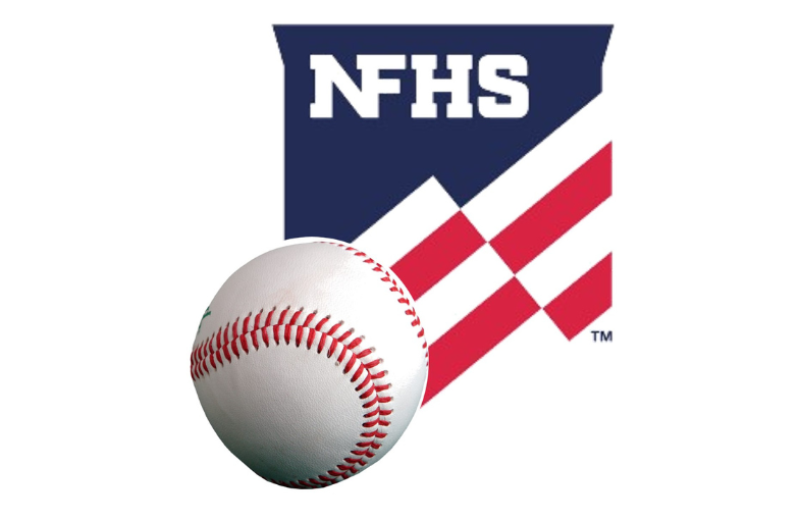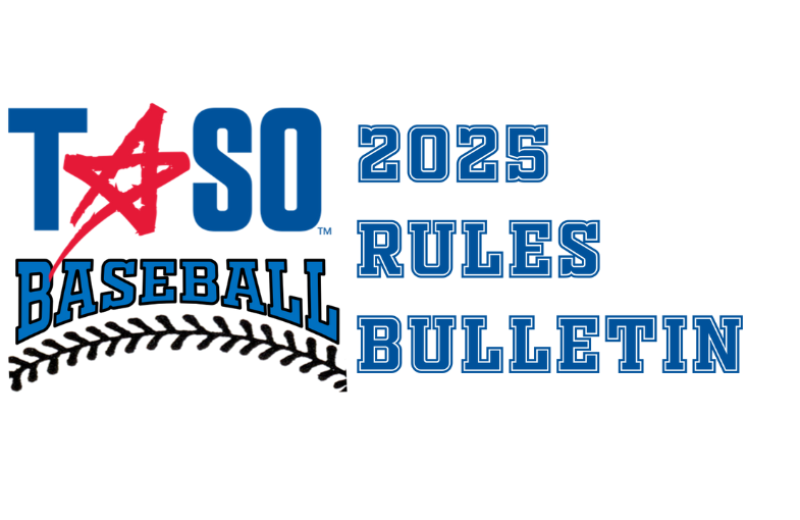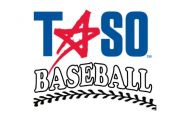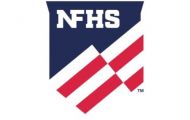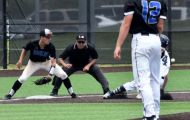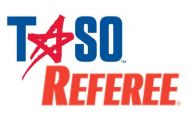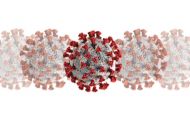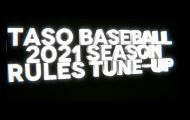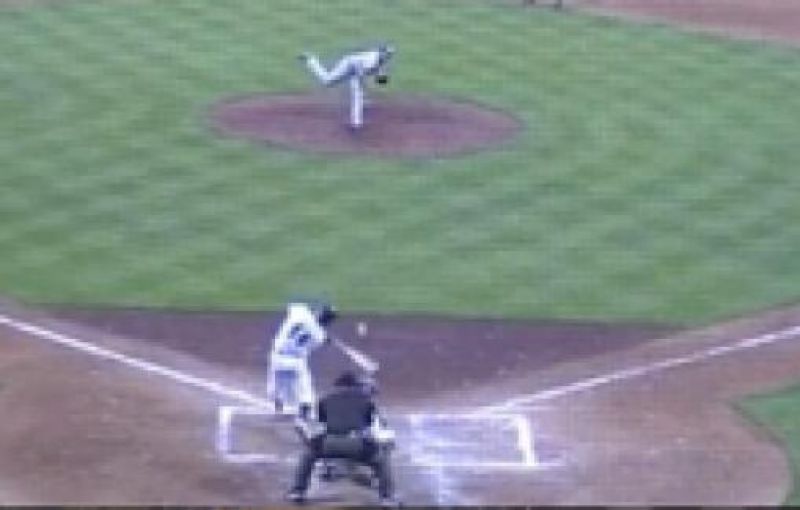
2019 NFHS Baseball Rules Interpretations
Publisher’s Note: The National Federation of State High School Associations is the only source of official high school interpretations. They do not set
aside nor modify any rule. They are made and published by the NFHS in response to situations presented.
Dr. Karissa L. Niehoff, Publisher, NFHS Publications © 2019
SITUATION 1: The pitcher, in his de‑ livery motion, comes off the pitching plate and replants his pivot foot in the dirt in front of the pitching plate pri‑ or to releasing the ball. His coach says this “crowhop” is legal. RULING: This is an illegal pitch. The pitcher cannot replant his pivot foot during the deliv‑ ery. (6‑1‑1, 6‑1‑2, 6‑1‑3)
SITUATION 2: The batter comes to bat wearing a helmet with a “jaw and cheek protector” attached to the hel‑ met. His coach states that the combina‑ tion is legal while the opposing coach maintains that the helmet is now illegal and cannot be worn. RULING: With all the possible combinations of prod‑ ucts on the market, it is not feasible for an individual umpire to know what is legal and what is not. It is the respon‑ sibility of the head coach to know if helmets with the “jaw and cheek pro‑ tector” attached are compliant. (2‑10‑2, 4‑1‑3b)
SITUATION 3: Before the game, the plate umpire is provided three base‑ balls that have the NFHS Authenticat‑ ing Mark but not the SEI/NOCSAE certification mark. RULING: For the 2019 season, these baseballs are com‑ pliant. Effective January 1, 2020, both the SEI/NOCSAE and the NFHS Au‑ thenticating Mark will be required on all baseballs used in high school com‑ petition. (1‑5‑3)
SITUATION 4: The batter hits a hard one‑hop ground ball back to the pitch‑ er. The pitcher makes a great stab on the ball, gloving it in the webbing of the glove. With the batter‑runner fast approaching first base, the pitcher is unable to quickly pull the ball out of the glove’s webbing. The pitcher takes a few fast steps toward first base and
takes his glove, with the ball in the webbing, and shovels it to the first baseman who catches the glove with the ball prior to the arrival of the bat‑ ter‑runner. RULING: The batter‑run‑ ner is out. The first baseman had secure possession of the ball and glove before the batter‑runner touched first base. (2‑ 9‑1, CB 2.9.1 SITUATION D)
SITUATION 5: The pitcher assumes the set position with his non‑pivot foot entirely in front of the front edge of the pitching plate, and the pivot foot parallel to the pitching plate, but with only the toe of his pivot foot in contact with the pitching plate. RULING: This is legal. The entire pivot foot no longer needs to be touching the pitching plate. As long as some part of the pivot foot is in contact with or directly in front of the pitcher’s plate and is parallel to it, it is a legal set position. (6‑1‑3)
SITUATION 6: The pitcher is in the set position with the heel of the pivot foot in contact with the pitcher’s plate and the rest of the pivot foot is (a) on an an‑ gle toward home plate, or (b) parallel to the pitcher’s plate. RULING: Only part of the pivot foot is required to be touching the pitcher’s plate with the pivot foot being parallel to the pitcher’s plate. The position in (a) is illegal, and in (b) legal. (6‑1‑3)
SITUATION 7: R1 is off with the pitch, which the batter hits high and deep down the first‑base foul line. As the ball is caught at the fence, R1 has missed second base and is standing on third when the ball goes dead on an overthrow. R1 retreats to first base and touches second base as he returns. RULING: Had the ball not been dead, R1’s retreat would have been legal and his touching of second on his return
would satisfy his baserunning require‑ ments under the principle of “last time by.” However, since R1 was on third base (the succeeding base from the missed second base) when the ball be‑ came dead, he cannot return to second base and/or first base. If the defense le‑ gally appeals his missing second base on his advance, he would be declared out. (8‑2‑5, 8‑2‑6l)
SITUATION 8: The visiting team ar‑ rives at the field and the umpires notice that, while each jersey has a number on its back that is at least 8 inches high, the numbers are not a “plain Arabic style.” RULING: The game is to be played. While the style of the numbers are not exactly what is required, they are legi‑ ble. If the state association desires, the umpires may make a game report. (1‑ 4‑3)
SITUATION 9: A thrown ball acciden‑ tally hits a photographer who is walk‑ ing from outside the media area to the dugout. Should interference be called? RULING: Unless the photographer in‑ tentionally moved so that he was hit by the thrown ball, it is not interference and the ball remains in play. The pho‑ tographer shall be instructed to remain in the media area during live‑ball play. If the photographer intentionally inter‑ fered with the thrown ball, the ball is dead and penalties shall be handled as if it was spectator interference. (1‑2‑8, 5‑1‑1l, 8‑3‑3e)
SITUATION 10: The home team has a uniform with the team motto em‑ broidered at the top of the back of the jersey. The motto is not offensive or unsportsmanlike in nature. RULING: This is not legal. If there are no other jerseys or shirts available for the team to use, the game is still to be played and a report shall be made to the state
association office. (1‑4‑3)
SITUATION 11: No outs and no run‑ ners on base when the batter swings and misses strike three that is in the dirt. As the batter‑runner takes off for first, the catcher moves to pick up the ball and throw it to the first baseman. Meanwhile, the plate umpire has also moved to see the resulting action bet‑ ter and inadvertently interferes with the catcher’s throw, which sails to the outfield. The batter‑runner advances to second base. RULING: It is only um‑ pire interference if the act is specifically identified as umpire interference in the rules. By rule, it is umpire interference when a plate umpire hinders, impedes or prevents a catcher’s throw attempt‑ ing to prevent a stolen base or retire a runner on a pickoff play. Any other oc‑ casion where an umpire hinders a play is to be considered incidental contact. The intent of the rule for umpire inter‑ ference by a plate umpire is to prevent the possibility of interference where a catcher is trying to throw immediately after a pitch, and the umpire has to be in position to see that pitch, and there is contact. In this play, it is incidental contact and the result of the play shall stand. (2‑21‑2, 8‑3‑6)
SITUATION 12: The batter enters the batter’s box with a bat that has a bat knob sensor embedded in the knob of the bat. RULING: Sensor technol‑ ogy embedded in the bat is legal for practice but is illegal for competition. Therefore, the bat is an illegal bat. The ball is dead, the batter is declared out and the head coach is restricted to the bench for the remainder of the game. (4‑1‑3b PENALTY, 5‑1‑1c, 7‑4‑1a)
SITUATION 13: With one out and a runner on first base, the defense brings in a substitute pitcher. After one pitch to the batter, the pitcher successfully picks off the runner at first base. The coach now wants to make another pitching change. RULING: The home plate umpire will not allow this pitch‑ ing change. The substitute pitcher must pitch to the batter then at bat, or any substitute for that batter, until such
batter is out or reaches first base, or un‑ til a third out has been made. (3‑1‑2)
SITUATION 14: A sharp line drive is hit to the second baseman. The im‑ pact of the ball takes the glove off the second baseman’s hand, and the glove lands on the ground with the ball still in the pocket of the glove. The second baseman retrieves the glove and takes the ball out of the pocket. Is this a catch or must the ball be thrown to first base in an attempt to record the out? RUL‑ ING: This is not a catch. To record the out on the batter‑runner, the second baseman would need to throw the ball to first in an attempt to obtain the force out. A catch is an act of a fielder gain‑ ing secure possession in his hand or glove of a live ball in flight and firmly holding it. (2‑9‑1)
SITUATION 15: S1 comes in as a relief pitcher. As he takes his warm‑up pitch‑ es, the opposing coach argues that he has now exceeded the maximum num‑ ber of pitches a pitcher is allowed by the state association restrictions. RUL‑ ING: Since S1 never threw a pitch, he has not exceeded his state association restrictions. The defensive team is al‑ lowed to replace him with an eligible relief pitcher. (6‑1‑6)
SITUATION 16: R2, on second base, rounds third and runs into F5 as he at‑ tempts to field a foul fly ball. This ac‑ tion occurred with (a) a count of 1‑1;
(b) a count of 1‑2; or (c) two outs. RUL‑ ING: In all three instances, R2 is out for his interference. In (a), the batter returns to bat with a count of 1‑2 and in (b), the batter returns to bat with a count of 1‑2 as the pitch is treated as a foul for the batter’s count. In (c), the batter will lead off in his team’s next of‑ fensive half‑inning. (7‑4‑1f)
SITUATION 17: The visiting team is wearing “quarterback‑style” wrist‑ bands that have defensive plays list‑ ed under a Velcro flap. The pitcher is wearing a black wristband down near his fielding glove. The home coach claims that the wristbands are illegal, and all players must take them off. RULING: Provided the wristbands
are not dangerous, they are legal. If the plate umpire judges the wristband worn by the pitcher to be distracting, he would need to remove it. Other‑ wise, it is legal for the pitcher as well. (1‑5‑9, 6‑2‑1f PENALTY)
SITUATION 18: The head coach re‑ quests “Time” and goes to the mound for a visit. He removes F1 and brings in S1 to pitch from the bullpen. The coach remains at the mound talking with S1 as he takes his eight warm‑ up throws. The opposing head coach claims that this is a charged conference because the defensive coach stayed at the mound until S1 had completed his warm‑up throws. RULING: There is no charged conference to be recorded against the team on defense since F1 was removed as the pitcher. As long as the head coach leaves when S1 completes his warm‑up throws and does not delay the game, no defensive conference will be charged. (3‑4‑1)
SITUATION 19: As the head coach moves to the pitching mound for a defensive conference, he tosses a baseball to his third baseman and has him take warm‑up throws with another player to get ready to pitch. RULING: A team cannot have a fielder, who is in the game, throw a baseball for the purpose of warming up as a pitcher during a defensive conference or a pitching change. If the team desires to warm up a player in the game to prepare him to pitch, it would need to take him out of the game to warm up and then later re‑enter him under the substitution rule. (3‑4‑1)
SITUATION 20: With the bases loaded and the runner on third base breaking for home, the batter swings at a pitch, hitting it high in the air between the pitching mound and home plate. As the plate umpire declares “Infield fly if fair,” the ball lands on the ground and rolls back toward home. As the runner from third is sliding to the plate, the ball contacts him in fair ground. RUL‑ ING: The ball is immediately declared dead. The batter is out for the infield fly and the runner is out as well. (2‑19, 5‑1‑1‑f1, 8‑4‑2‑k2)

